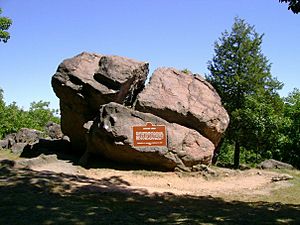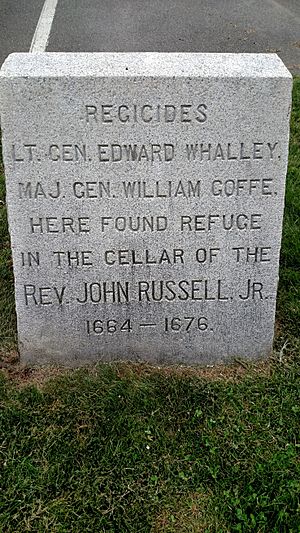William Goffe facts for kids
Quick facts for kids
William Goffe
|
|
|---|---|

Judges' Cave, where Goffe and Edward Whalley reputedly hid during the early part of their exile in New England
|
|
| Member of Parliament for Hampshire |
|
| In office September 1656 – February 1658 |
|
| Rule of the Major-Generals, responsible for Berkshire, Sussex and Hampshire | |
| In office November 1655 – January 1657 |
|
| Member of Parliament for Yarmouth |
|
| In office September 1654 – January 1655 |
|
| Personal details | |
| Born | c. 1613 to 1618 Uncertain, probably Sussex |
| Died | c. 1679 New England |
| Resting place | Thought to be Hadley, Massachusetts |
| Nationality | English |
| Spouse | Frances Whalley (c. 1650) |
| Children | Anne; Elizabeth; Frances |
| Military service | |
| Rank | Major General |
| Battles/wars | |
William Goffe was an English soldier who lived in the 1600s. He was born around 1613 to 1618 and passed away around 1679. He was known as a "Roundhead" because he supported the Parliament during the Wars of the Three Kingdoms.
Goffe was a very religious person. People even called him "Praying William." He was involved in the decision to remove King Charles I from power in 1649. After the king's supporters regained control, Goffe had to leave England. He escaped to New England to avoid being arrested.
He held important roles in the government after the king was removed. He worked closely with Oliver Cromwell, a powerful leader of the Parliament's army. After Cromwell's son, Richard Cromwell, stepped down in 1659, Goffe lost much of his power.
Just before the king's family returned to power in 1660, Goffe sailed to Boston. He traveled with his father-in-law, General Edward Whalley, who was also involved in the king's removal. They were hidden by people who supported their cause in New England. Not much is known for sure about his life there. Some stories say he was the "Angel of Hadley," a mysterious figure who helped defend a town from attack in 1675. However, this story is debated. He is believed to have been buried in Hadley, Massachusetts.
Contents
Who was William Goffe?
William Goffe was the fourth of five sons. His father, Stephen Goffe, was a priest. His mother was Deborah. The exact date and place of William's birth are not known for sure. His father was a priest in Bramber, Sussex, but he lost his job for supporting a group called the Puritans.
William's older brother, Stephen Goffe, became a priest too. He even worked for the king's family who were living outside England. William's other brothers were merchants in London. William himself became an apprentice in 1634, learning a trade. Around 1650, William Goffe married Frances Whalley. She was the daughter of General Edward Whalley. William and Frances had three daughters: Anne, Elizabeth, and Frances.
William Goffe and the English Civil War
In 1634, William Goffe started working as an apprentice in London. He was briefly put in prison in 1642. This happened because he helped organize a request for Parliament to control London's army. The First English Civil War began in August 1642. By July 1643, Goffe was a captain in the Parliament's army.
His army unit helped defend Gloucester and fought in the First Battle of Newbury. In 1644, his unit had to surrender at Lostwithiel. But they recovered and fought again at the Second Battle of Newbury.
In 1645, Goffe joined the New Model Army. This was a very important army for Parliament. Over the next year, his unit fought in many battles. These included Naseby, Langport, and Torrington. They also helped in sieges like Bridgwater and Bristol. The war ended in June 1646 when Oxford surrendered.
After the war, there were arguments between army leaders and members of Parliament. In 1647, Goffe was part of a group that asked Parliament to remove certain members who opposed the army. Goffe was then promoted to major.
Goffe believed that the return of Jesus Christ was very near. He thought that continuing talks with King Charles I was stopping God's plan. He even argued with Oliver Cromwell about this.
When the Second English Civil War started in 1648, Goffe's regiment helped stop a rebellion in South Wales. They recaptured Pembroke Castle. They also defeated a Scottish army at Preston. Goffe, now a Lieutenant Colonel, believed that the new fighting was a punishment from God. He felt it was because the king had not been held accountable.
In December 1648, Parliament members who opposed removing the king were forced out. The remaining Parliament decided to put King Charles on trial. Goffe was one of the 59 judges who approved the king's removal from power in January 1649.
Scotland crowned Charles I's son as their king in 1650. This led to another war between England and Scotland. Goffe commanded Cromwell's own army unit at the Battle of Dunbar in September 1650. He was then promoted to colonel. A year later, he fought at the Battle of Worcester. These victories ended the war. Charles II escaped, and Scotland became part of England. Cromwell became the leader of the new republic.
Life After the War
Goffe was rewarded for his service with land. He supported the removal of the old Parliament in 1653. He also supported Cromwell becoming the Lord Protector, the new leader of England. Goffe became one of Cromwell's most loyal supporters. He was elected as a Member of Parliament for Great Yarmouth in 1654.
In 1655, he helped stop a rebellion that supported the king. He was promoted to major general in October 1655. He was in charge of the areas of Berkshire, Sussex, and Hampshire. This system was not popular or cheap. In 1656, Goffe was elected as a Member of Parliament for Hampshire.
Cromwell was offered the chance to become king, but he refused. It's not clear if Goffe wanted Cromwell to be king, but he accepted the decision. A new part of Parliament was created, similar to the old House of Lords. Goffe was one of the 63 people chosen for it. However, this new group did not last long.
When Cromwell died in September 1658, Goffe supported Cromwell's son, Richard Cromwell. But Richard could not control Parliament or the army. He resigned in May 1659. This ended Goffe's time of power.
Life in Exile and Death
In 1660, the king's family was returning to power. A general pardon was offered for past actions, but not for those who had been involved in the king's removal. Knowing they would be arrested, Goffe and his father-in-law, Edward Whalley, sailed to Boston, Massachusetts on May 13, 1660. They arrived on July 27.
They first lived openly in Cambridge. But when it was confirmed they were not pardoned, it became too risky for the local leaders to protect them openly. In March 1661, they moved to New Haven, Connecticut. Another person involved in the king's removal, John Dixwell, joined them there.
They were hidden by a local priest, John Davenport. When people looking for them arrived in May, Goffe and Whalley hid in Judges' Cave. They stayed there for several years.

In 1664, they moved to Hadley, Massachusetts, where John Russell sheltered them. After this, not much is known about their lives. Goffe sent letters to his wife Frances. These letters showed he still held his strong religious and political beliefs. It seems they even ran a small trading business. Whalley died sometime between 1674 and 1675.
In the 1800s, some people thought Goffe might have been the "Angel of Hadley." This was a person who supposedly helped defend the town from a Native American attack in 1675. However, it's not clear if this event even happened, or if Goffe was involved. Goffe reportedly left Hadley in 1676. His last letter to his wife is from April 1679. It is thought he died soon after this. He is believed to be buried next to his father-in-law in Hadley.
Legacy
Many towns in New England have streets named after Dixwell, Whalley, and Goffe. These include Hadley and New Haven. William Goffe and Edward Whalley are characters in a 2022 book called Act of Oblivion by British author Robert Harris. The book tells the story of their escape across New England.
Images for kids
-
St Nicholas church, Bramber, where Goffe's father served as parish priest until c. 1607
-
Oliver Cromwell, c. 1649; Goffe was one of his most loyal supporters



